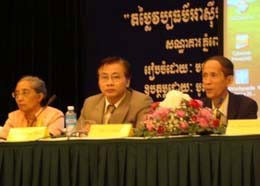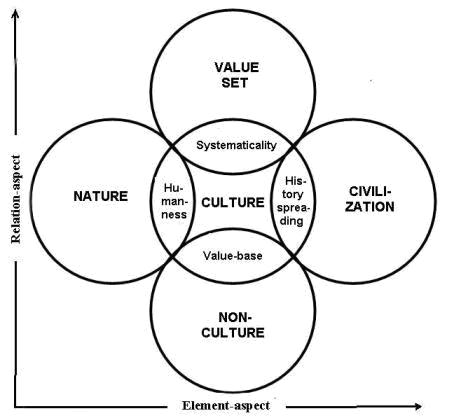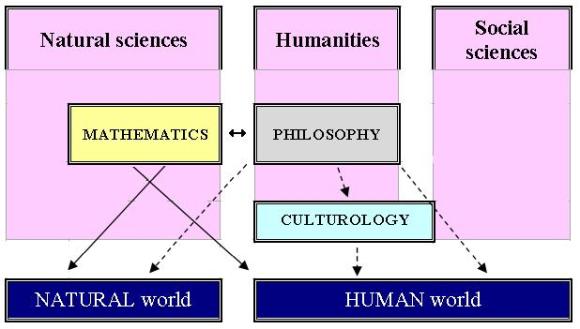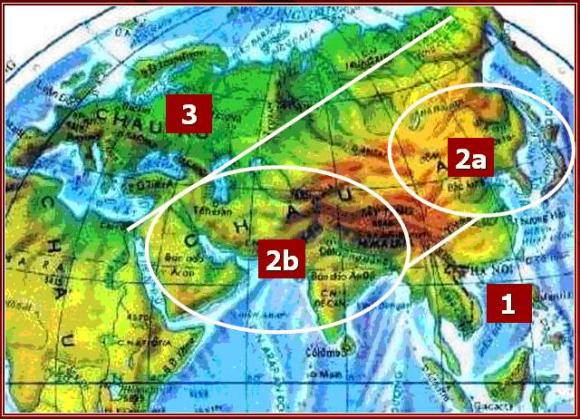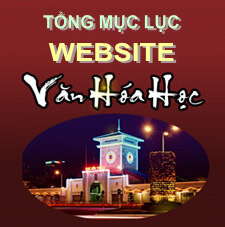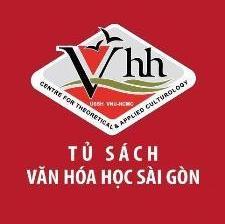I- The approaching way of researching culturological theories
Unlike the other presently culturology-majoring scholars using the term "cultural studies" to indicate the science and consider it as a part of anthropology, we decide to use the term "culturology" (культурология, 文化學) and consider culturology as an independent science. The science of culturology has its own object of study, position and research methods etc...
This concept is supported by Russian and Chinese scholars rather than scholars from European or American nations (mainly base on the term "culture studies", likely unifying culture studies and cultural anthropology).
In Vietnam situation, many educational and researching units in this field are of this European-American way.
In brief, in our opion, culture is identitied through four typical characteristics: systematicality (systematic completion), value-base, humanness and historical spreading. One can easily distinguish culture with the other four notions: value set, non-culture, nature and civilization (picture 1).
Picture 1: Identifying culture
Culturology is identified as a human science bordering to social sciences, the science with its object of study is "culture" with the capacity of a system of symbolic values, the science with the researching approach based on multi-disciplinary qualitative theories, large-scale researching sphere and high genaralization capacity (picture 2).
Picture 2: The position of culturology
(solid arrow - quantitative relations; interrupted arrow - qualitative relations)
On the position of culturology, as we got to know, the popular concept in China ranks culturology at the second position: below philosophy and above all the other social sciences and humanities [Nguyen Ngoc Tho 2006].
Our concept is quite near to Chinese scholars', however, it is not totally homogeneous in detail. The difference can be found at the point: we don't put these relations in the well-arranged ranking of the sciences. The differences between philosophy, mathematics, culturology and the other sciences are only the result of the scientific works' assignment (or sharing). Each science has its own strong and weak points. The sciences of philosophy, mathematics and culturology may cover larger sphere in handling relating facts (or events); therefore, they need to have higher generalization capacity than any other sciences. In return, they are far to be the same as the other sciences in term of specilization capacity and particularization level. If one science covers larger sphere of study, it cannot go deeper in specilization, and if it is deeply specilized, it is unable to cover larger sphere of study. Therefore, all sciences are equal.
Unlikely the cultural anthropology which applies the experimental researching method and focuses on participation observation and fieldwork survey, we consider culturology as a theoretical science for it mainly works with materials brought from the other social sciences and humanities. The practical observation and fieldwork survey can offer supplementary but uncompulsory materials. Among theoretical methods applied in sciences, we priorly focus on the systematic - typological method.
II- The approaching way of researching world cultures
By using the systematic and typological method, we define the starting point of research by distinguishing between Oriental and Occidental cultural traditions. From that perspective, we come to distinguish the difference between the cultural types of two areas: agricultural-originated cultural type and nomadic-originated cultural type. And from the angle of generalization capacity, we classify into mobility-dominated cultural type and tranquillity-dominated cultural type.
Between these two typical types, there exists the intermediate type which contains attributes of all two typical types mentioned above. In particular analysis in the case of Euro-asia continent - the cradle of mankind culture, the typical tranquillity-dominated (重静) is the cultural type of the whole ancient Southeast Asian region while the typical mobility-dominated (重动) is of European region. All the regions from Southwest Asia, India to Siberia and Northeast Asia are of the intermediate cultural type. This large strip of land can be divided into two smaller sub-regions: secularity-esteeming intermediate cultural type in Northeastern sub-region (2a); and spirit-esteeming intermediate cultural type in Southwestern sub-region (2b).
Picture 3: Worldwide cultural regions
The complete picture of cultural types and cultural region classifications in the Euro-asia continent can be described in picture 3 and in chart 1:
Chart 1: Cultural types and cultural regions
|
Attribute |
CULTURAL TYPE |
CULTURAL REGION |
||
|
YIN阴 |
1- tranquillity-dominated |
1. Southeastern region |
||
|
YIN-YANG HARMONY 阴阳融合 |
2- inter-mediate |
2a- spirit-esteeming |
2. transitional region |
2a. Southwestern sub-region |
|
2b- secularity-esteeming |
2b. Northeastern sub-region |
|||
|
YANG阳 |
3- mobility-dominated |
3. Northwestern region (Occident) |
||
Upon these contrary pairs, we can define a list of characteristics of each cultural type. From that basis, a series of cultural events or phenomena in different regions (areas) can be identified clearly.
III- Basic characteristics of tranquillity-dominated cultural type
1. In the behaviour to natural environment, the farmers are deeply dependent up on the nature, they live stably in one place with their own house for almost the whole life, grow their own plants in the fields, consequently, the consciousness of respecting the nature (nature-respecting) has been fully shaped in their mind which don't allow them to compete with the nature. Living in the harmony with the nature - is the desire of the residents of all the Oriental tranquility-dominated cultures. In nomadic cultures, one when finding that the present place is of inconvenience will make it easy to move, such situations gradually lead to the psychology of disregarding the nature; therefore, people of the Occidental mobility-dominated cultures always keep in mind the ambition (desire) of conquering and controlling the nature.
Each behaviour has its own strong and weak points. The behaviour of respecting the nature guides people to preserve their living environment, but in the dark side, it makes people become hesitating and shy. The behaviour of disregarding the nature can encourage people to be brave to deal with the nature and promote the scientific development, however, in the dark side, it causes the damage to the environment.
2. In cognitive aspect, in the farming (husbandry), especially the wet-rice cultivating farming, farmers live in deep dependence up on the nature - this is not only correct in any individual phenomenon, it is precise to all farmers' living natural conditions: the sky (heaven), the earth, the sunshine, the rain... This is undoubtedly the source of the collective (general) thinking way. The nature of collective thinking way makes people pay attention not to each individual elements consisted but to the whole reciprocal relations between them. This is the important characteristic of thinking way of people in the tranquility-dominated cultures, typically in the wet-rice cultivating cultures.
On the contrary, the nomads pay full care on specific objects such as the cattles, the livestocks etc.. That perfect whole makes the nomads's thought become the analytical thinking way to separate the component factors; to partition the whole thing into inner parts. The analytical thinking way leads to the consequence of valueing the elements, to abstract (isolate) the elements out of the reciprocal relations. It is the key characteristic of thinking way of people in the mobility-dominated cultures in which the Occidental cultures are considered to be typical.
4. On the regulations of community-organizing, the farmers prefer organizing by the love-based rule. The whole neighbourhood living together stably in long term must join to create the harmonious love-based living environment. The love-based living way produces the consciousnesses of virtue (righteousness)-respecting, literature-respecting (schooling-respecting, as opposed to physical strength-respecting), women-respecting. It was not accidental that many Western writers called the typical wet-rice agricultural region of Southeast Asia as "the matriarchal region" (le Pays du Matrircat).
As we go further to the north (China) and the west (India), the situation of sex discrimination (male-dominated only) has been proving to be clearly serious. In the West, the community-organizing regulations appear to be physical strength-respecting, force-based, talent-respecting, male-dominated.
The collective, dialectical and thoughtful thinking way of the love-based farmers decides their community-organizing way to be flexible which allows them to adjust to be suitable (reasonable) in each specific situation. The love-based living regulation and the desire of having a peaceful life have made their flexible living way to be more profound, and have become the peaceable psychological foundation in dealing with all kinds of social relations.
The farmers, in need of having a love-based life, have to respect each other and treat each other equally (democratic). It is the rural democratic base which appeared much earlier than both the Oriental feudal democracy and the Western bourgeois democracy. The love-based living way and equally-treated behaviour have produced the most important characteristic of agricultural culture: the psychology of community-respecting.
In the contrary, the analytical and metaphysical thinking way of the mobility-dominated cultures will lead to the regulation-based community-organizing mode which directly relates to the principle-respected living way (as in the Western extreme saying: rationalism). In order to maintain the rules and the disciplines, the mobility-dominated cultures create the way of treatment which gathers the absolute power in hand of the leaders (monarchical). The analytical thinking way and the regulation-based community-organizing rule etc. has brought the psychology of individual-respecting. In the mediaval ages and the previous times, the individual-respecting mode appeared to be leader-respecting, and from the bourgeious democratic time on, it has turned out to be personal-respecting (respecting toward each individual).
While the regulation-based mode shows its dark side of being dogmatic and rigid and the dark side of the monarchical mode is of being unequally imposed, the reverse of the flexibility is the arbitrariness (unsystematicality) and the reverse of the rural democracy is the illness of defying the national laws/rules. The love-based mode and the flexibility have made the farmers' organizing spirit to be worse than that of the nomads.
5. In the behaviour to social environment, the collective thought and the flexible manners of agricultural culture also regulate the amalgamated (harmonized) behaviour in receiving cultural flows from the outside world and the soft (flexible), peaceable attitude in dealing the pressures from the outside world; while the strength-respecting and mobility-dominated cultural mode and regulation-based living way have made Western people become ethnocentric in receiving the cultural flows from the outside world and ironclad, hungry for success in dealing with the outside world (as they like solving the conflicts by using army forces and always keep in mind the ambition of having the opponent's absolute submission).
6. These are two basic cultural types covering the whole world. Every culture in this world is included within these cultural types. However, it is advisory that we should not understand the rule mechanically. In the process of shaping cultural types, natural condition is said to hold the leading controlling role, but when they appear in the specific manifestations, natural and social conditions both have the same important impacts on them. As a result, these above-mentioned cultural type have become mingled to each other under diversified forms. This diversity can be simply converged into three rules:
|
CRITERION |
TRANQUILITY-NOMINATED CULTURE (agriculture-originated) |
MOBILITY-NOMINATED CULTURE (nomadic) |
|
|
The behaviour to natrural environment |
Respecting and living in harmony with the nature |
Defying and having the ambition of controlling the nature |
|
|
Cognitive way and thinking way |
Inclining to collective and dialectical (relation-respected); subjective, impulsive and experience-based |
Inclining to analytical, metaphysical (element-valued); |
|
|
Community-oganizing |
Organizing principles |
Love-respecting, virtue (righteousness)-respecting, Literature-respecting, women-respecting |
physical strength-respecting, force-based, talent-respecting, male-dominated |
|
Organizing modes |
Being flexible, democratice, community-based |
Being principle-based, monarchical and individual-based |
|
|
The behaviour to social environment |
Being harmonized in receiving other culture, being soft and peaceable in dealing with the outside pressures |
Being ethnocentric in receiving other culture; being ironclad and hungry for success in dealing with the outside forces |
|
Table 2: Comparing the characteristics of two cultural types
IV- Southeast Asian cultural identities
The above-mentioned tranquility-dominated cultural traits are precisely the characteristics of Southeast Asian cultural identities. They are the core and the original characteristics which control all the other minor cultural traits and help distinguish the whole Southeast Asian culture from the other cultural regions.
Just the quanquility-dominated nature of Southeast Asian culture has made the region easily accept Indian Buddhist influence (as to compare with the ironclad Brahmanism/Hinduism). It has profoundly softened the Chinese cultural flows when being imported into Vietnam in comparing with Chinese culture in China itself and Chinese culture in Korea or in Japan. Similarly, this nature has deeply softened the Islamic tradition when being imported into Malaysian and Indonesian cultures in comparing with the Islamic cultures in the Middle East; and the Christian nature in the Philippines in comparing with the Christian world in Europe.
References
1. Nguyen Ngoc Tho (2006) Lý luận văn hoá học ở Trung Quốc (Culturological theories in China). - http://www.vanhoahoc.edu.vn/site/index.php?option=com_content&;task=view&id=24&Itemid=62 .
2. Tran Ngoc Them (1995) Cơ sở văn hóa Việt Nam (Basic Vietnamese culture), Ho Chi Minh city, University Press (500 pgs.), 1996 (380 pgs.), 1997 (280 pgs.); Education Publishing House, 1st - 2nd - 3rd printed in 1997, 1998, 1999 (340 pgs.).
3. Tran Ngoc Them (1996) Tìm về bản sắc văn hóa Việt Nam (Discovering the identity of Vietnamese culture), Ho Chi Minh city, Ho Chi Minh city Press: 1996, 1997 (670 pgs); 2001, 2004, 2006 (680 pgs.). French translation: Recherche sur l'identite de la culture vietnamienne. - Edition The Gioi, 2001, 2006. - 852 pgs.
4. Tran Ngoc Them (1997) Vấn đề phương pháp luận trong việc đi tìm bản sắc văn hoá Việt Nam (Some methodological issues in the process of discovering Vietnamese identities). - In: Tạp chí Triết (Philosophy Magazine), No. 3+4-1997, pgs. 155-162.
5. Tran Ngoc Them (1999) Vấn đề bản sắc văn hóa dân tộc Việt Nam (The issue of Vietnamese national identities). - In: Tạp chí khoa học xã hội (Social Sciences Magazine), No. 42, 1999, pgs. 24-32.
6. Tran Ngoc Them (2000) Khái luận về văn hóa (The outline on culture), In: Phác thảo chân dung văn hóa Việt Nam (Skech out of Vietnamese culture portrait), Ha Noi, National Politics Press, pp. 17-36.
7. Tran Ngoc Them (ed) (2003) Văn hoá học và văn hoá Việt Nam (Culturology and Vietnamese culture), Ha Noi, Educational University Press.
8. Tran Ngoc Them (2004) Vai trò của tính cách dân tộc trong tiến trình phát triển ở Hàn Quốc (có so sánh với Việt Nam) (The role of national nature in the Korean development (in the comparition with situation in Vietnam)), In: Nghiên cứu con người (Human Studies), No. 6 (15), 2004, pp. 53-60.
9. Tran Ngoc Them (2005) Trung Hoa từ góc nhìn địa văn hoá (China from the geo-culural point of view). - In: - Trung Quốc với vùng văn hoá chữ Hán (China and the Chinese writing cultural area). - USSH, Ho Chi Minh City, pgs. 24-32.



